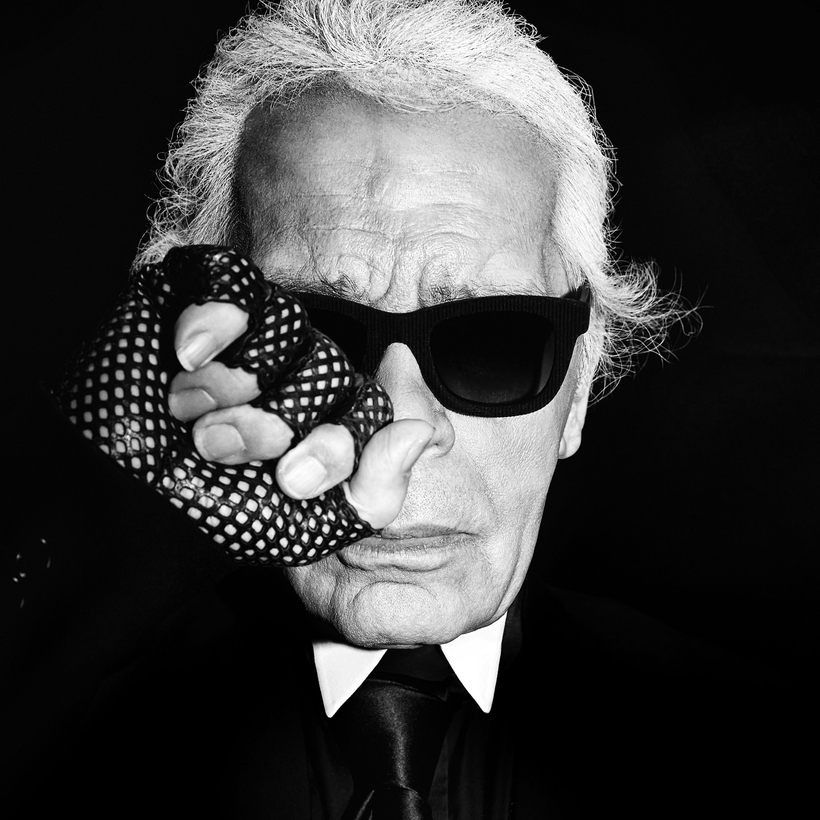In recent decades, few figures have been able to create a public image as authoritative as Karl Lagerfeld. He made himself immediately recognizable, all around the world, using only a handful of elements: sharply tailored dark suits; high-collared, crisp white dress shirts; jet-black sunglasses; powdered hair pulled back into a ponytail; and a seemingly endless supply of cutting, clever quips.
And the German fashion designer, who helmed Chanel from 1983 until his death, in 2019, made it clear that he knew precisely what he was doing. In the fall of 2004, he was backstage before a Chanel show, talking with the actress Nicole Kidman and the filmmaker Baz Luhrmann, just before Kidman’s surprise entrance would cause a near riot. “It’s not my show,” Lagerfeld explained. “It’s our show. We’re all performers!”

A few years later, Lagerfeld was standing in the photography studio he had created on the Rue de Lille, in Paris—with its tens of thousands of books stacked floor to ceiling, two stories in height, on all four walls—being photographed by Jean-Baptiste Mondino. Lagerfeld realized that he needed to take a break to check his hair and makeup. “I’ll be right back,” he said jauntily to Mondino. “Time to go freshen up the marionette!”
That image is part of what makes Lagerfeld so interesting, but telling the story of someone’s life needs to go deeper—it has to reveal who he was offstage. The biggest challenge in writing Paradise Now, my new book on Lagerfeld, was to capture the designer as he really was.
Personal experience was helpful. I was fortunate enough to have met Lagerfeld in 1995, when I was the Paris bureau chief for Women’s Wear Daily and W. Once I began to know him, I was struck by the difference between the harsh public persona and the warmth of the man I saw in private. When I told him that, he replied, “Better that than the opposite, non?”

And he was right: there are plenty of people whose image is much warmer than the reality. The great interior designer Jacques Grange crystallized one example. Having worked with Yves Saint Laurent and Pierre Bergé for decades, and having kept a friendship with Lagerfeld on the side, he was in a good position to observe the difference between the two.
“Karl was much more tender than he appeared,” Grange told me. “He used his public persona to protect himself, but in reality he was very sensitive, much more sensitive than Yves. Yves pretended to be very sensitive, but in reality he didn’t give a shit.”
That is not to say that Lagerfeld, privately, did not have an edge. One good friend of his, Patrick Hourcade, an expert on the French 18th century, told me about a dinner given by Lagerfeld at his house on the Rue de l’Université for Jeff Koons and his wife at the time, the former porn star La Cicciolina. After they left, Lagerfeld said, “Of the two, the biggest prostitute is not the one that you might think.”
Another key resource for writing my book was primary research—Lagerfeld’s own correspondence. In December 2021, in Monte Carlo, Sotheby’s had the first of several auctions of Lagerfeld’s estate. I asked the auction house if I could review some of the items that seemed to be important biographically.

One was key: a scrapbook filled with material around the Woolmark Prize, the December 1954 design competition that Lagerfeld won (along with a then 18-year-old Saint Laurent). Lovingly assembled by Lagerfeld’s mother, and kept with her throughout her life, it contained one particularly important document that had never been seen: an eight-page letter that Lagerfeld had written his mother back in Hamburg, just after the ceremony, telling her everything about what had happened on the biggest night of his life up to that point.
He had chosen to wear a narrow velvet tie, in aubergine, that he had picked up at the Pierre Cardin boutique. The designer Pierre Balmain, who gave him a job that night, complimented him on his tie. “Was it tasteful, I don’t know,” Lagerfeld wrote. “But it was noticed and that is the only thing that matters to me. I don’t care what people say as long as they say something.”
There was certainly some bravado in his statement to his mother. But it also proved that, even at the tender age of 21, before his career had officially begun, Lagerfeld was very conscious of the image that he was creating. Plus ça change …

William Middleton’s Paradise Now: The Extraordinary Life of Karl Lagerfeld will be published on February 28 by Harper
